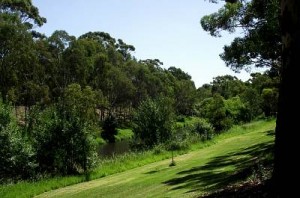… to “Pilta Wodli” , the “Possum House” in the language of the Aboriginal people on the Adelaide Plains, today called the Kaurna Nation.
This place, situated at the northern banks of the man-made Torrens Lake at the edge of city centre of Adelaide, has been the hub and the focal point of the encounter between Aboriginal people and four German Lutheran missionaries in infant South Australia between 1838 and 1853. What mission history eventually considered a “failure”, has been in hindsight a success story and a blessing: The recording of three Aboriginal languages in South Australia by the missionaries then serve today as some of the main sources for the reclaiming these languages since the early 1990s.
This “research blog” will collect information and details regarding my research on this story. Due to the nature of academic research I will mainly deal with documents around this story, collected in Germany, Great Britain and South Australia. Essentially, however, this is the story of the Aboriginal peoples affected by the work of these four missionaries during the British and German settler invasion in early South Australia.
Please be aware:
- The pages in this blog will change without notice! While you may use its content for your own studies and research, I would advise not to reference them. Some time in the future I will set up another website with more reliable content. Thank you for your understanding.
- For Aboriginal visitors: This blog will quote, refer to, or show pictures of, people of Aboriginal descend who may have passed away.
Background
Just over two years after the official proclamation of what is now South Australia, at the end of October 1838, the first two of eventually four German Lutheran missionaries arrived at the shores of the infant British colony. Clamor Schurmann (1815-1893) and Gottlob Teichelmann (1807-1888) set immediately out to learn the language of the local Aboriginal, the “Adelaide tribe” as they were then called. Two years later they published an extensive word list, grammar and collection of sentences of what is now called the “Kaurna” language. Schurmann learned two more languages, “Ramindjeri” at Encounter Bay (about 100 km south of Adelaide) and “Barngarla” (previously “Parnkalla”) on Eyre Peninsula (800 km west).

“Pilta Wodli” (Possum House), the former Native Location at the River Torrens in Adelaide, South Australia
(Photo: Gerhard Ruediger, 2011)
Supported by Aboriginal elders, the two missionaries opened the first school for Aboriginal children at this place, then called the “Native Location”, in December 1839.
In 1841, two more German Lutheran missionaries arrived in Adelaide. While Samuel Klose continued teaching at Pilta Wodli, Eduard Meyer and his young wife Fredericke from Berlin began mission work at Encounter Bay. Meyer published a dictionary of the local vernacular (Ramindjeri, a sub-group of the Ngarrindjeri Nation) in 1842, and so did Schurmann for the Barngarla language (1846). Between the four, they also published three ethnographic studies of the people with whom they worked, wrote many letters and published articles in contemporary newspapers.
From today’s perspective, Klose became important not only as a teacher in the Kaurna language at Pilta Wodli, but also for his far-sighted vision to send letters about, and manuscripts written by, his students to the Dresden Missionary Society in Germany, thus documenting their achievements and securing some of the first documents written by Aboriginal children in South Australia in their own vernacular.
The missionaries ceased their work in 1846 by acknowledging that they had failed to convert not one Aborigine to the Christina faith. By then, more than 50,000 settlers had driven away the few hundred Aboriginals on the pre-contact Adelaide Plains. However, in the early 1990s, the surviving Aborigines and linguists re-discovered these dictionaries which today allow the successful reclaiming of Aboriginal Languages that were considered extinct or severely threatened in their survival.
This Website
As mentioned, this blog will serve as a research notebook. I intend to collect information of all sorts in some organised manner and accessible from different places. However, please be aware that these are notes only, NOT a systematically researched and evidenced summary of the story, or elements of it. While you may make use of the information, this website will change frequently in both structure and content.
As a German migrant to Australia in 2006, English is my second language. Please let me know if passages can not be understood sufficiently. Thank you.
Access and Use
One of the side issues of this blog is to offer my research to the wider public, in particular to the descendants of the Aboriginal families from way back then, but also to those who relate to any of the families in Australia established by the four young German missionaries who never returned “home” to Germany.
Please feel free to use the post commentary function of this blog to provide further information where applicable. Thank you. (Spam will be deleted.)
A research like this can never occur on your own — I would therefore like to acknowledge the support of all the people in the past and future who have accompanied, supported, challenged, hindered (!) or advised me on my journey, of which I would have never thought it to happen.

Warning: Illegal string offset 'cookies' in /home/grweb478/public_html/PiltaWodli/wp-includes/comment-template.php on line 2422